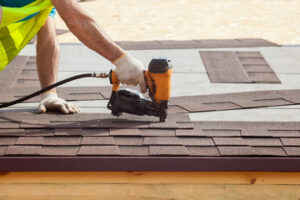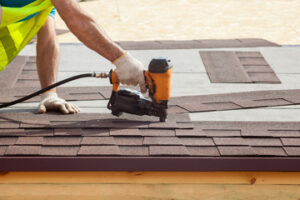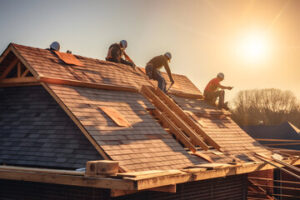Roofing installation has evolved into a science of protection, precision, and design balance. It now combines aesthetics with long-term functionality. Professionals are focusing more on smart planning than ever before. Each layer plays a vital role in a home’s safety and efficiency.

Digital measurement tools now provide accuracy before a single nail is driven. Drones and laser mapping capture slope angles and surface irregularities. This eliminates guesswork and improves installation planning. Labor and material waste are significantly reduced. Learn More Here by reading the article below.
New substrates are designed to handle both weight and flexibility. These underlayers absorb minor structural movement over time. They also serve as moisture barriers under the visible roofing material. Longevity begins beneath the surface with proper support.
Roof ventilation is becoming a key part of installation strategy. Balanced airflow prevents mold, heat buildup, and material warping. Modern roofs are planned with intake and exhaust points in harmony. This passive system supports both comfort and durability.
Adhesive and sealing technology now responds to specific climate zones. Formulas vary depending on temperature ranges and humidity levels. Customized bonding ensures the roof stays intact year-round. These specialized materials outperform older generic solutions.
Fasteners are no longer one-size-fits-all components. Installers now match them to roof type, slope, and structural load. Screws and nails vary in coating, threading, and size. The correct choice prevents corrosion and pull-out over time.
Synthetic membranes are replacing older materials in moisture-prone areas. These products resist water intrusion even during severe weather. They remain flexible under freezing and extreme heat conditions. Layering these smart barriers prevents deeper damage later.
Impact-resistant materials are now considered in high-risk regions. Roofing that absorbs shock without breaking saves repair costs. These surfaces also prevent interior leaks after heavy debris impact. Smart material choice can mean fewer insurance claims.
Green roofing systems are gaining traction in modern installation projects. Vegetation-based surfaces are integrated with drainage and root barriers. They provide insulation and reduce heat island effects. This makes homes more sustainable and energy-efficient.
Cool roofing techniques use reflective surfaces to manage heat absorption. Light-colored and treated materials reflect solar energy away. This reduces interior temperatures and air conditioning demand. Comfort is preserved while energy consumption drops.
Roof geometry has a direct impact on performance and appearance. Steeper slopes shed water faster but demand more complex framing. Low-pitch designs require special sealing to prevent pooling. Geometry must complement material, climate, and architectural goals.
Installation staging is being optimized for worker safety and timeline efficiency. Crews now operate in phases with dedicated equipment zones. Material placement is mapped before lifting to the roof. These logistics reduce delay and site accidents.
Pre-cut systems allow materials to arrive ready for exact placement. Manufacturing aligns cuts to project dimensions before delivery. This reduces labor hours and limits on-site saw use. Precision and speed combine in every install step.
Noise-dampening layers are now available under roofing materials. These additions reduce rain sound and outside noise intrusion. Acoustic comfort is a growing factor in roof design. Even stormy nights feel quieter and more serene.
Thermal sensors are used during installation to detect potential flaws. These devices highlight cold spots and uneven insulation. Crews make real-time adjustments before sealing the final layer. Errors are prevented rather than fixed post-installation.
Weather forecasting tools now influence scheduling and material application. Installers avoid moisture-sensitive tasks during rain-prone windows. Flexible schedules are matched to weather data for success. A dry install means a stronger, longer-lasting result.
Solar-ready roofing is becoming part of the design conversation early on. Roofs are now built to accommodate panel load and wiring paths. This futureproofs homes for renewable upgrades. Energy integration begins with smart foundational decisions.
Edge detailing is becoming more important to prevent wind uplift. Eaves and ridges are reinforced with anchor flashing and wrap-seals. Proper edges reduce entry points for rain and drafts. The final border holds everything else in place.
Insulated roof panels are now manufactured with multiple integrated layers. These combine core insulation with outer waterproof membranes. They provide quick coverage with less layering needed. Install time shortens while performance increases.
Color matching now involves digital renderings before decisions are finalized. Homeowners preview roofing choices against siding and landscaping. Visual simulations lead to better satisfaction after installation. Beauty and performance now go hand in hand.
Fire-resistant layers are mandatory in more jurisdictions due to stricter codes. Materials are tested for flame spread and ignition resistance. These elements offer extra protection in dry or wildfire-prone areas. Safety is planned into every square foot.
Modular roofing kits are used in compact housing and prefab construction. Panels snap into place with connectors and guides. Installation is fast, uniform, and ideal for tight deadlines. Innovation meets practicality in this streamlined method.
Historical property roofing requires a blend of new and traditional materials. Crews replicate original aesthetics using safer, longer-lasting components. This preserves the visual story while upgrading performance. Restoration becomes both respectful and effective.
Gutter integration is now a key component during roof installation. Seamless channels are embedded into the design from day one. This improves drainage and reduces exterior wall damage. Water is guided away efficiently without detracting from the look.
Non-penetrating mounts are used for accessories like antennas and safety rails. These avoid drilling directly into waterproof layers. Instead, they rely on weight or clamp systems for stability. Roof integrity stays intact while functionality expands.
Roofing warranties are often based on installation quality, not just materials. Proper nailing, alignment, and layering must meet manufacturer specs. A flawless install secures coverage for decades. Responsibility and precision pay off long after the crew leaves.
Roof safety anchors are pre-installed for future maintenance work. These anchor points provide harness attachment during inspections. It encourages safe upkeep for years to come. A secure roof must also support those who protect it.
Technicians use moisture meters during sheathing checks before layering. These meters ensure the wood base is dry and mold-free. This prevents fungal issues from festering under sealed surfaces. Prevention starts with thorough inspection.
Color retention coatings now help roofs resist sun bleaching. These coatings block UV damage and reflect damaging rays. Roofs retain their vibrancy even under strong sun exposure. A long-lasting appearance is part of material performance.
Wind tunnel tests are now part of pre-approval for new roofing types. Engineers evaluate uplift resistance and flow behavior. These results guide fastener spacing and edge reinforcement. Data drives better choices before the roof is even built.
Safety scaffolding is now custom-fit for roofing stages. Adjustable rails and toe boards are installed around sloped areas. Installers work freely with reduced fall risk. The safety setup reflects the seriousness of modern site planning.
Waste reduction is addressed through take-back programs. Manufacturers reclaim offcuts and packaging after delivery. These are recycled or reused in future products. Roofing becomes a closed-loop process rather than a landfill burden.
Drone documentation provides aerial photos of each install phase. These images are archived for compliance and client records. It offers proof of progress and serves as a maintenance reference. A visual timeline adds professionalism and clarity.
Training programs now simulate complex installations using virtual tools. Workers learn advanced techniques without stepping on a roof. Mistakes are corrected in virtual space before real work begins. The outcome is safer, faster, and more accurate builds.
Reflective coatings are tested for slope-specific performance. Steeper roofs reflect differently than flat ones due to angle. Coatings are now engineered to match slope for better efficiency. Every surface works smarter with tailored materials.
Future roofing systems may include built-in sensors for damage alerts. These embedded chips send data when impact or leaks occur. Homeowners receive instant notifications to act quickly. The roof becomes a responsive part of the smart home system.
Roofing installation is no longer a single-step solution. It’s a thoughtful process that merges art, science, and responsibility. From measurement to final inspection, precision matters at every level. The modern roof is a carefully engineered crown for every structure.

